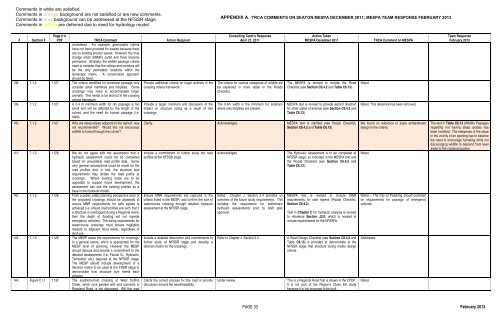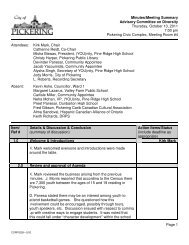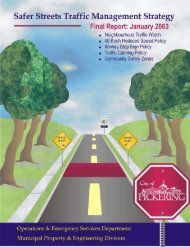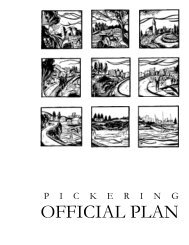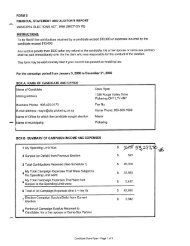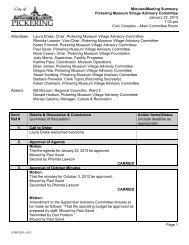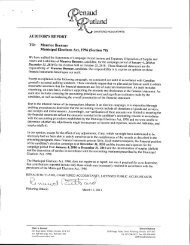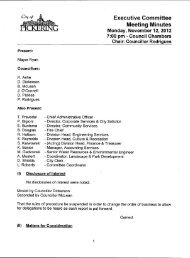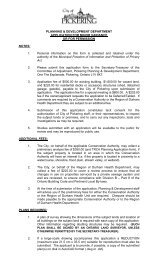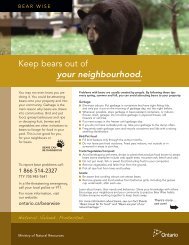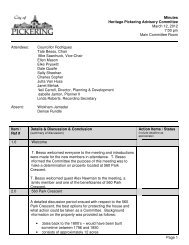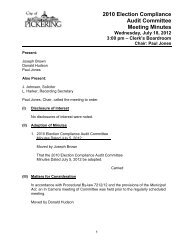Chapter A - Introduction - City of Pickering
Chapter A - Introduction - City of Pickering
Chapter A - Introduction - City of Pickering
You also want an ePaper? Increase the reach of your titles
YUMPU automatically turns print PDFs into web optimized ePapers that Google loves.
Comments in white are satisfied.<br />
Comments in orange background are not satisfied or are new comments.<br />
Comments in blue background can be addressed at the NFSSR stage.<br />
Comments in yellow are deferred due to need for hydrology model.<br />
APPENDIX A. TRCA COMMENTS ON SEATON MESPA DECEMBER 2011; MESPA TEAM RESPONSE FEBRUARY 2013<br />
# Section #<br />
Page # in<br />
PDF TRCA Comment Action Required<br />
considered. For example, geomorphic criteria<br />
have not been provided for swales because there<br />
are no existing erosion issues. However this may<br />
change when SWMFs outlet and flows become<br />
permanent. Similarly, the wildlife passage criteria<br />
need to consider that the valleys and corridors will<br />
be the only permeable locations within the<br />
landscape matrix. A conservative approach<br />
should be taken.<br />
138. 7.1.2 1127 The criteria identified for terrestrial passage only<br />
consider small mammals and herptiles. Some<br />
crossings may need to accommodate larger<br />
animals. This needs to be laid out in the crossing<br />
criteria framework.<br />
139. 7.1.2 1127 A 0.4 m minimum width for dry passage is too<br />
small and will be affected by the length <strong>of</strong> the<br />
culvert, and the need for human passage (i.e.<br />
trails).<br />
140. 7.1.2 1127 Why are steep slopes adjacent to the right-<strong>of</strong>- way<br />
not recommended? Would this not encourage<br />
wildlife to funnel through the culvert?<br />
141. 7.1.3 1128 We do not agree with the assumption that a<br />
hydraulic assessment could not be completed<br />
based on unavailable road pr<strong>of</strong>ile data. Some<br />
very general assumptions could be made for the<br />
road pr<strong>of</strong>iles and, in fact, the structure size<br />
requirements may dictate the road pr<strong>of</strong>ile at<br />
crossings. Where existing roads are to be<br />
upgraded to support future development, the<br />
assessment can use the existing pr<strong>of</strong>iles as a<br />
base in the hydraulic model.<br />
142. 7.1.3 1128 From a public safety planning perspective each <strong>of</strong><br />
the proposed crossings should be assessed to<br />
ensure MNR requirements for safe egress is<br />
achieved (i.e. ensure road pr<strong>of</strong>iles are such that if<br />
a structure is overtopped during a Regional event,<br />
then the depth <strong>of</strong> flooding will not impede<br />
emergency vehicles). The sizing requirements for<br />
watercourse crossings must ensure negligible<br />
impacts to adjacent flood levels, regardless <strong>of</strong><br />
land use.<br />
143. 7.1.3 1128 The MESP states the requirements for crossings,<br />
in a general sense, which is appropriate for the<br />
MESP level <strong>of</strong> planning. However the MESP<br />
should discuss and provide a commitment to the<br />
detailed assessments (i.e. Fluvial G., Hydraulic,<br />
Terrestrial, etc.) required at the NFSSR stage.<br />
The MESP should include development <strong>of</strong> a<br />
decision matrix to be used at the FSSR stage to<br />
demonstrate how structure size meets each<br />
criterion.<br />
144. Figure C1.1 1132 The southern-most crossing <strong>of</strong> West Duffins<br />
Creek, which runs parallel with and connects to<br />
Rossland Road, is not discussed. Will this road<br />
Provide additional criteria for larger animals in the<br />
crossing criteria framework.<br />
Provide a larger minimum and discussion <strong>of</strong> the<br />
impact on structure sizing as a result <strong>of</strong> trail<br />
crossings.<br />
Consulting Team’s Response<br />
April 27, 2011<br />
The criteria for various categories <strong>of</strong> wildlife will<br />
be explained in more detail in the Roads<br />
Checklist.<br />
The 0.4m width is the minimum for locations<br />
where only herptiles are present.<br />
Action Taken<br />
MESPA December 2011<br />
The MESPA is revised to include the Road<br />
Checklist (see Section C6.4.2 and Table C6.13).<br />
MESPA text is revised to provide explicit direction<br />
for other suites <strong>of</strong> animals (see Section C6.4.2 and<br />
Table C6.13).<br />
Clarify. Acknowledged. MESPA text is clarified (see Roads Checklist,<br />
Section C6.4.2 and Table C6.13).<br />
Include a commitment to further study the road<br />
pr<strong>of</strong>iles at the NFSSR stage.<br />
Ensure MNR requirements are captured in the<br />
criteria listed in the MESP, and confirm the size <strong>of</strong><br />
watercourse crossing through detailed hydraulic<br />
assessment at the NFSSR stage.<br />
Include a detailed description and commitments to<br />
further study at NFSSR stage and develop a<br />
decision matrix for the crossings.<br />
Clarify the correct process for this road or provide<br />
discussion around the need/feasibility.<br />
Acknowledged.<br />
Noted. <strong>Chapter</strong> J, Section 2.4 provides an<br />
overview <strong>of</strong> the future study requirements. This<br />
includes the requirement for preliminary<br />
hydraulic assessments prior to draft plan<br />
approval.<br />
Refer to <strong>Chapter</strong> J, Section 2.4.<br />
Under review.<br />
The Hydraulic Assessment is to be completed at<br />
NFSSR stage, as indicated in the MESPA text and<br />
the Roads Checklist (see Section C6.4.2 and<br />
Table C6.13).<br />
MESPA text is revised to include MNR<br />
requirements for safe egress (Roads Checklist,<br />
Section C6.4.2).<br />
Text in <strong>Chapter</strong> C for hydraulic analysis is revised<br />
to reference Section J2.0, which is revised to<br />
include requirements for the NFSSRs.<br />
A Road Design Checklist (see Section C6.4.2 and<br />
Table C6.13) is provided to demonstrate at the<br />
NFSSR stage that structure sizing meets design<br />
criteria.<br />
This is a Regional Road that is shown in the CPDP.<br />
It is not part <strong>of</strong> the Region’s Class EA study<br />
because it is not proposed to be built.<br />
Noted.<br />
TRCA Comment on MESPA<br />
Noted. This reference has been removed.<br />
We found no reference to slope embankment<br />
design in the criteria.<br />
Noted.<br />
Noted – The <strong>City</strong> <strong>of</strong> <strong>Pickering</strong> should comment<br />
on requirements for passage <strong>of</strong> emergency<br />
vehicles.<br />
Addressed.<br />
Noted.<br />
Team Response<br />
February 2013<br />
The text in Table C6.13 (Wildlife Passage)<br />
regarding not having steep grades has<br />
been modified. The steepness <strong>of</strong> the slope<br />
in the vicinity <strong>of</strong> an opening has to balance<br />
the need to encourage funneling while not<br />
discouraging wildlife to descend from level<br />
areas to the crossing location.<br />
PAGE 33 February 2013


